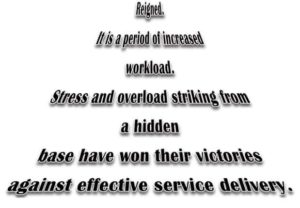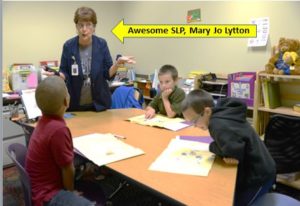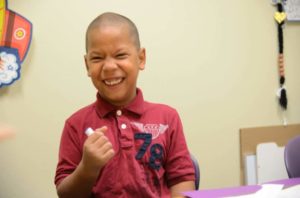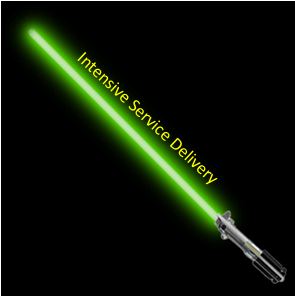A long time ago, in a setting not too, too far away…



After graduate school, I knew I would be a school-based speech-language pathologist. With the letters M.S. after my name, a bag filled with speech and language therapy goodness and a firm grasp on the ins-and-outs of working in a school, I was ready to tackle my profession. During my first year, the Schedule of Services page on the paperwork was easy to fill out. It was always 30 minutes, twice a week. Once in a blue moon, I would see a student once a week.
No one told me that I was caught in a pattern of service delivery for my students! To be honest, the combination of words “pattern-of-service-delivery” had no significance to me.

I would like to think that experience and knowledge made me change my ways. Rather, it was another SLP asking me why I used the aforementioned schedule. I did not have a good answer. It was the 2004-2005 school year, and I was going to start an intensive service delivery program for 3-5 year olds working on phonological patterns, articulation and expressive language. The data obtained from the Preschool Articulation and Language Services (PALS) program, an intensive model, in McKinney, TX, demonstrated students receiving approximately 2-4 hours of weekly, literacy-based therapy (also incorporating Barbara Hodson’s cycles approach) resulted in students graduating from speech services faster. The best part, their scores on reading assessments in Kindergarten were at or above peers who did not require speech and language services. So, students made quicker progress, and they did better in their general education classrooms? This is surely a win-win.
Watch our Texas State Presentation on Intensive Service Delivery
Let’s look at the research
In 2010, Gillam and Loeb reported four components of language intervention were associated with successful language outcomes: Intensity, Active Attention, Feedback and Rewards. Specifically, the study demonstrated that a 6-week intensive service delivery model showed 5x the gains as a traditional 2-year service delivery model (Gillam & Loeb, 2010). Recent studies found intensity as a consistent factor that contributed to increased language outcomes.
Now, I know what you are asking yourself. Can I do this as a living, breathing SLP who actually works in the schools? We are here to let you know that another school district has already done the work for you. Special Education director Keith Schneider made this happen during the 2012-2013 school year at Jarrell Elementary. With the great brain and passion of SLP Mary Jo Lytton, the powerhouse team tackled intensive service delivery. Here is where Dr. Ronald Gillam makes his second appearance in this post. Mary Jo used Dr. Gillam’s SKILL program (www.usuworks.usu.edu). Supporting Knowledge in Language and Literacy (SKILL) is a step-by-step guide designed to improve language skills that are aligned with the core curricular standards. This program not only tackles story grammar components, but it also addresses ways to elaborate language and writing. After seeing students daily for nine weeks, results on the Test of Narrative Language increased, on average, by 18 standard score points. Teachers reported seeing improved self-esteem in the classroom and measurable differences on reading scores.
Take a look at this pre- and post- story writing sample:
By seeing students every day, Mary Jo was able to address speech and language skills that made a direct impact in the classroom.
Scheduling may be a concern you have regarding this model. Here is what Mary Jo’s schedule looked like:
- 8:05-8:35 3rd and 4th grader
- 8:50-9:35 1st grade
- 9:45-10:30 Pre-Kindergarten
- 10:40-11:10 4th grade
- 2:05-2:50 Kindergarten
Brenden’s language, confidence and behavior has improved within this model.
How to try this out yourself
We also did some leg work for you. If you have a caseload of 50 students across two campuses, you could also go with this schedule:
Intensity: Students will receive 8 hours of therapy every six weeks
Alternating schedule: 3 groups of 16 students (1,2,3)
Each group will have a rotating schedule (a, b, c, d, e)
Group are rotated through two week cycles along with alternating daily schedule

Another possibility would be to see one campus for one grading period and then seeing the other campus for the next grading period. Gasp! I understand this goes against what we systemically have in place in the schools; nonetheless, the results show that with an intensive service delivery model we can improve student scores immensely, and, ultimately, graduate them from speech and language services quicker. That is our goal. We want our students to be in the general education curriculum and have the speech and language skills to function in their classrooms. Intensive Service Delivery may, in essence, be the light saber needed to provide more effective and efficient therapy services.
Resources:
- Gillam et.al (2008) , Loeb et. al. (2009), Tomblin, (2007), Gillam and Loeb (2010)
- Lytton, M., Palafox, P., Schneider, K. (2013) Jarrell Elementary: Making an Impact on Student Progress [Handouts]. Retrieved from Texas Council of Administrators of Special Education Interactive.











Here’s a link to the blog-post about Jarrell Elementary’s implementation of this. It includes a really incredible 24-minute video explanation about what they did. It’s awesome!
I love this idea. I encourage all slp’s to consider a different model than what we currently use. With current models students receive 36hrs of service with minimal carry-over. We need to empower our teachers and provide them with the supports needed so they can carry out the goals within the classroom setting.
My name is Gloria Rojas and I am a bilingual speech/language pathologist (Spanish/English) originally from Cuba.
Many years ago, another slp and I created a service delivery model that was non-traditional. We actually quit our day jobs, got hired by two big school districts in rural Vermont, and created an alternative model called Project ACCLAIM – A Communication Curriculum for Language Acquisition Instructional Methods. With 110 classrooms to serve, we split the classrooms, so that Linda served 55 and I served the other 55. We were in each classroom every other week. Knowing that the students needed daily services, it was imperative that we build capacity with our teachers. They had to carry out the lessons on daily basis. We developed daily plans that would cover the 2 weeks. Our professional development plan offered two 3-credit graduate level courses they were highly encouraged to take. The first course included the language structures that teachers needed to learn. The second course included how those language structures were going to be embedded within their language arts units. Did I mention that we also insisted on using brain-based teaching strategies? We used American sign language, music, movement, theater, art in our daily plans. We wrote and produced hundreds of songs, chants, etc. The program was also a literacy-based program where we included already published children’s literature. Our target goals included the IEP goals students had..so we pulled them out for about 15 minutes or so before going into their classrooms to pre-teach activities. It helped build confidence when they could be the leaders.
Needless to say, this was challenging yet one of the most rewarding experiences of my life. The program lasted 5-7 years, I can’t remember now. Hopefully, some of those teachers, if still around, are using the materials we/they created. We took pre-post data that showed significant growth. I wish we would’ve published the curriculum…I wish we would’ve done an efficacy study…
If you want to check out the music… Linda Stoler has four CD’s listed under Sign2Me. We probably used Literacy Rocks the most. Since then, I’ve created bilingual songs (Spanish/English) to target the needs of our Hispanic population. I’ve also started to write, create products on Teachers Pay Teachers.
Disclaimer: My intention here is not to sell products. My intention is to facilitate the process of moving from a service delivery model that needs some help. If you have any questions, please feel free to contact me at glomrojas@gmail.com.
Gloria,
Thank you so much for your thoughtful and passionate response! I whole-heartedly agree with your sentiment regarding service delivery models. With consideration to other models that better align with the general education curriculum, build capacity with teachers and focus on functional, educationally-based goals and objectives, our students are better served. I would love to chat with you about your program. I can be reached at phuong.palafox@bilinguistics.com. Your model, along with intensive services and the 3 to 1 model, can surely give school districts a continuum of service delivery models.
I also appreciate your use of brain-based strategies. This is a personal passion-topic for me. Not only is it more fun, but it specifically addressed evidenced-based strategies for our students who are from culturally and linguistically diverse populations (including the culture of poverty) and need additional sensory-based support for learning.
Last, thank you for sharing your music recommendations and sharing your products. It is always useful to know about resources that better contribute to our students’ and clients’ success. Thank you for sharing your passion and brain with us, Gloria. Collectively, we can do so much!
Phuong